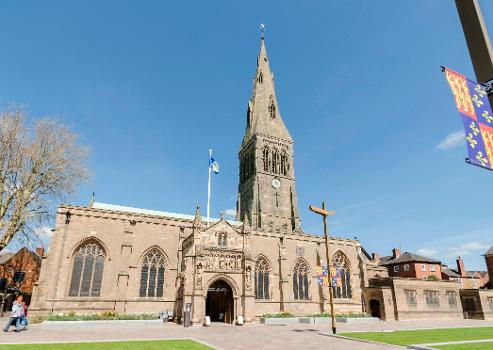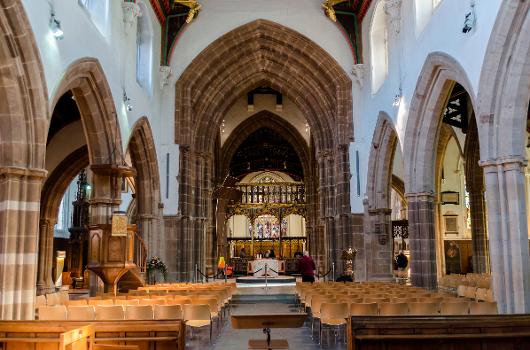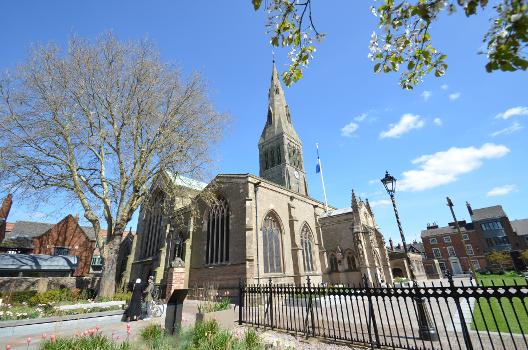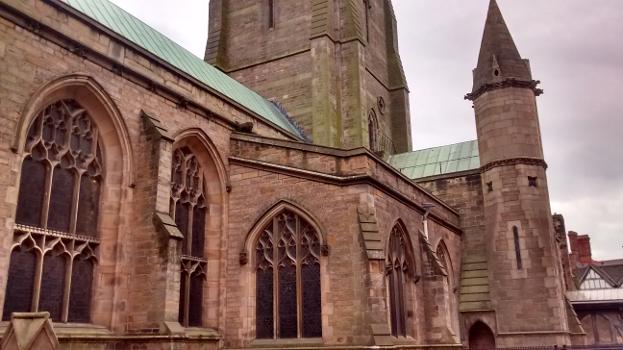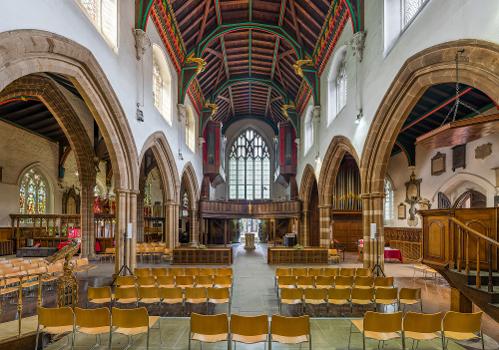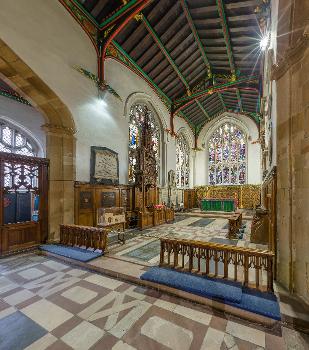General Information
| Other name(s): | Cathedral Church of Saint Martin |
|---|---|
| Beginning of works: | 1086 |
| Completion: | 1867 |
| Status: | in use |
Project Type
| Function / usage: |
Cathedral |
|---|---|
| Architectural style: |
Gothic |
| Material: |
Masonry structure |
Awards and Distinctions
Location
| Location: |
Leicester, Leicestershire, East Midlands, England, United Kingdom |
|---|---|
| Coordinates: | 52° 38' 5.04" N 1° 8' 13.44" W |
Technical Information
Dimensions
| tower | height | 67.1 m |
Excerpt from Wikipedia
The Cathedral Church of Saint Martin, Leicester, usually known as Leicester Cathedral, is a Church of England cathedral in the English city of Leicester and the seat of the Bishop of Leicester. The church was elevated to a collegiate church in 1922 and made a cathedral in 1927 following the establishment of a new Diocese of Leicester in 1926.
The remains of Richard III were buried in the cathedral in 2015 after being discovered nearby.
History
A church dedicated to St Martin has been on the site for about a thousand years, being first recorded in 1086 when the older Saxon church was replaced by a Norman one. The present building dates to about that age, with the addition of a spire and various restorations throughout the years. Most of what can be seen today is a Victorian restoration by architect Raphael Brandon. The cathedral of the former Anglo-Saxon diocese of Leicester was on a different site.
A cenotaph memorial stone to Richard III was until recently[ when?] located in the chancel; it was replaced by the tomb of the king himself. The monarch, killed in 1485 at the Leicestershire battlefield of Bosworth Field, had been roughly interred in the Greyfriars, Leicester. His remains were exhumed from the Greyfriars site in 2012 and publicly identified in February 2013. Peter Soulsby, Mayor of Leicester, and David Monteith, the cathedral's canon chancellor, announced the king's body would be reinterred in Leicester Cathedral in 2015. This was carried out on 26 March.
The East Window was installed as a monument to those who died in World War I. The highest window contains a sun-like orb with cherubs radiating away from it. In the centre Jesus sits holding a starry heaven in one hand with one foot on a bloody hell. Surrounding Jesus are eight angels whose wings are made from a red glass. To the far right stands St Michael the Archangel, who stands on the tail of a dragon. The dragon goes behind Jesus and can be seen re-emerging under the feet of St George who stands on its head. On the bottom row can be seen from left St Joan of Arc, Mary, Jesus with crying angels, Mary Magdalene, James, and St Martin of Tours. The window includes an image of a World War I soldier..
The tower and spire were restored both internally and externally in 2004–5. The main work was to clean and replace any weak stonework with replacement stone quarried from the Tyne Valley. The cost was up to £600,000, with £200,000 being donated by the English Heritage, and the rest raised through public donations.
The cathedral has close links with Leicester Grammar School which used to be located directly next to it. Morning assemblies would take place each week on different days depending on the school's year groups, and services were attended by its pupils. The relationship continues despite the school's move to Great Glen, about seven miles south of Leicester.
In 2011, after extensive refurbishment, the cathedral's offices moved to the former site of Leicester Grammar School, and the building was renamed St Martin's House. The choir song school also relocated to the new building, and the new site also offers conference rooms and other facilities that can be hired out. The new building was officially opened by the Bishop of Leicester in 2011.
In July 2014, the cathedral completed a redesign of its gardens, including installation of the 1980 statue of Richard III. Following a judicial review decision in favour of Leicester, plans were made to reinter Richard III's remains in Leicester Cathedral, including a new tomb and a wider reordering of the cathedral interior. Reinterment took place on 26 March 2015 in the presence of Sophie, Countess of Wessex (representing the Queen) and Prince Richard, Duke of Gloucester.
On 13 April 2017, Elizabeth II distributed Maundy money in the cathedral to 182 recipients.
Architecture
Leicester Cathedral is a Grade II* listed building comprising a large nave and chancel with two chancel chapels, along with a 220-foot-tall spire which was added in 1862. The building has undergone various restoration projects over the centuries, including work by the Victorian architect Raphael Brandon, and the building appears largely Gothic in style today. Inside the cathedral, the large wooden screen separating the nave from the chancel was designed by Charles Nicholson and carved by Bowman of Stamford. In 2015 the screen was moved eastward to stand in front of the tomb of Richard III, as part of the reordering of the Chancel by van Heyningen and Haward Architects.
Vaughan Porch
The Vaughan Porch which is situated at the south side of the church was designed by J. L. Pearson, who was also the architect of Truro Cathedral. It is named the Vaughan Porch because it was erected in memory of the Vaughans who served successively as vicars throughout a great part of the nineteenth century. The front of the porch depicts seven saintly figures set in sandstone niches, all of whom are listed below.
- Guthlac c 673–713 was a Christian saint from Lincolnshire who lived when Leicester was first made a diocese in the year 680
- Hugh of Lincoln c 1135–1200 was a French monk who founded a Carthusian monastery and worked on the rebuilding of Lincoln Cathedral after an earthquake destroyed it in 1185. In Norman times Leicester was situated within the Diocese of Lincoln.
- Robert Grosseteste c 1175–1253 was an English statesman, scholastic philosopher, theologian, scientist and Bishop of Lincoln. He is also the most famous of the medieval Archdeacons of Leicester.
- John Wycliffe c 1329–1384 was an Oxford scholar and is famous for encouraging two of his followers to translate the Bible into English. Foxe's famous "Book of Martyrs" (which commemorates the Protestant heroes of the reformation era) begins with John Wycliffe.
- Henry Hastings c 1535–1595 was the 3rd Earl of Huntingdon. The Leicester home of the Earls of Huntingdon was in Lord's Place off the High Street in Leicester, and Mary, Queen of Scots stayed there as a prisoner on her journey to Coventry.
- William Chillingworth 1602–1643 was an Oxford theologian, a friend of Jeremy Taylor and nephew of Archbishop Laud. He was Master of Wyggeston Hospital and became a Chaplain to the Royalist army in the Civil War.
- William Connor Magee 1821–1891 was Bishop of Peterborough and encouraged the building of many of Leicester's famous Victorian churches and a large number of parochial schools. He appointed the first suffragan Bishop of Leicester, Francis Thichnesse, in 1888. Magee later became Archbishop of York.
Chapels
The cathedral contains four separate chapels, three of which are dedicated to a different saint. St Katharine's and St Dunstan's Chapels act as side chapels and are used occasionally for smaller services and vigils. St George's Chapel, which is located at the back (or west) of the cathedral commemorates the armed services, and contains memorials to those from Leicestershire who have been killed in past conflicts. The new Chapel of Christ the King adjoins the East Window.
St Katharine's Chapel is located on the north side of the Cathedral to the left of the sanctuary. In the window above the altar is St Katharine, who was tied to a wheel and tortured (hence the firework named after her). Below this is a carved panel showing Jesus on the cross with Mary and John on either side of him. St Francis of Assisi and the 17th-century poet Robert Herrick are also pictured — indeed, the chapel is sometimes referred to as the "Herrick Chapel".
St Dunstan's Chapel, located on the other side of the chancel to St Katharine's Chapel, is specially put aside for people to pray in. A candle burns in a hanging lamp to show that the sacrament of Christ's body and blood is kept here to take to those who are too ill to come to church. The walls of the chapel are covered with memorials to people who have prayed in the chapel. St Dunstan was Archbishop of Canterbury in the 10th century, and scenes from his life are depicted in the south-east window.
St George's Chapel was the chapel of the Guild of St George. The effigy of England's national saint, on a horse, was kept here and borne through the streets annually on 23 April in a procession known as "riding the George". The legend of George killing a dragon is shown in one of the chapel's windows. The chapel, enclosed by a carved wooden screen, was reconstructed in 1921 and contains memorials to the men of the Royal Leicestershire Regiment. Here the battle honours of the Regiment and the names of those killed in the Crimean, South African and two World Wars are recorded and remembered.
The new Chapel of Christ the King was created at the east end of the cathedral as part of the re-ordering work for the burial of Richard III.
Text imported from Wikipedia article "Leicester Cathedral" and modified on July 23, 2019 according to the CC-BY-SA 4.0 International license.
Participants
Currently there is no information available about persons or companies having participated in this project.
Relevant Web Sites
- About this
data sheet - Structure-ID
20035362 - Published on:
09/03/2008 - Last updated on:
05/05/2024

